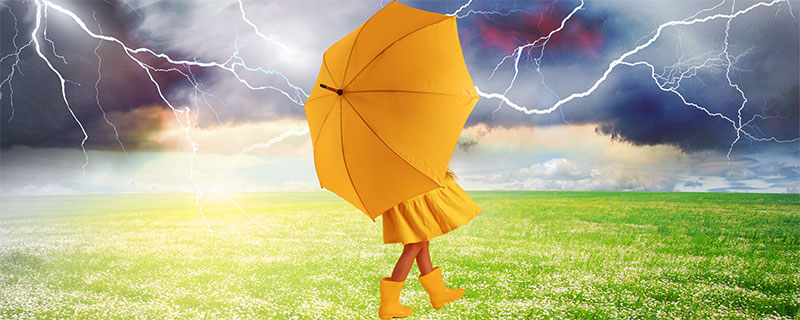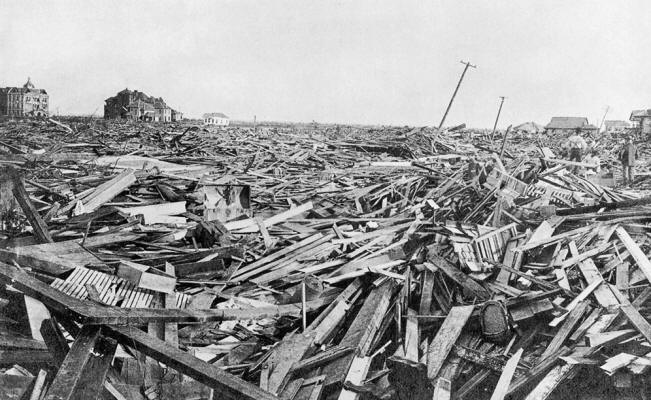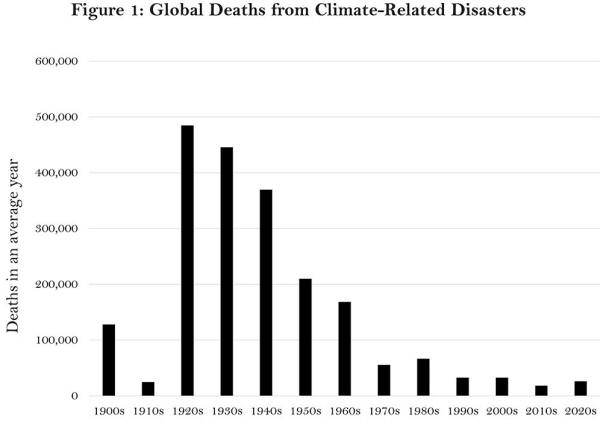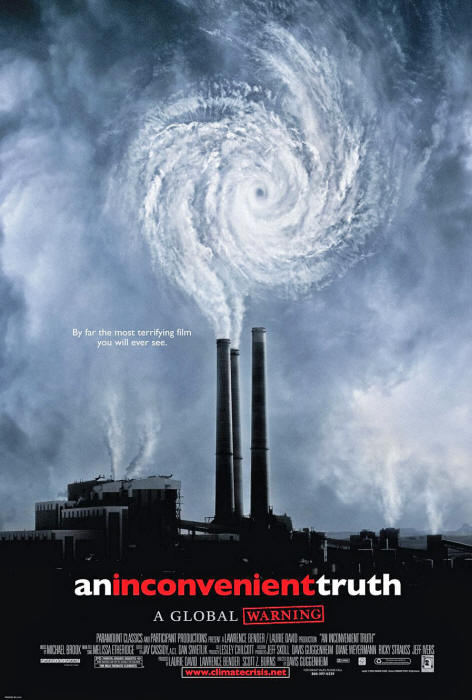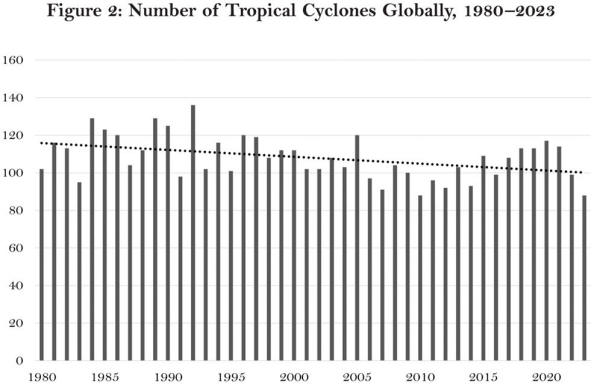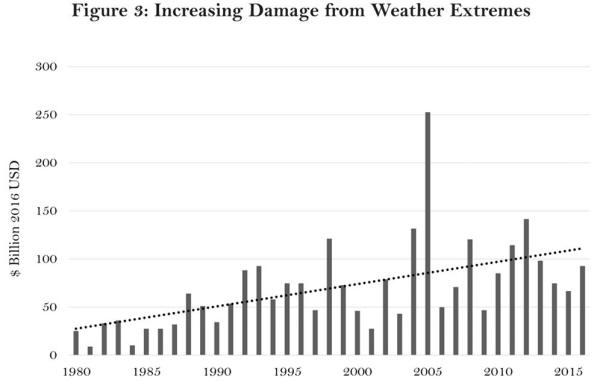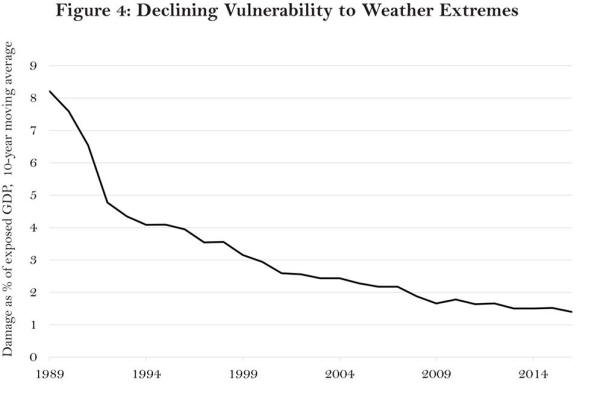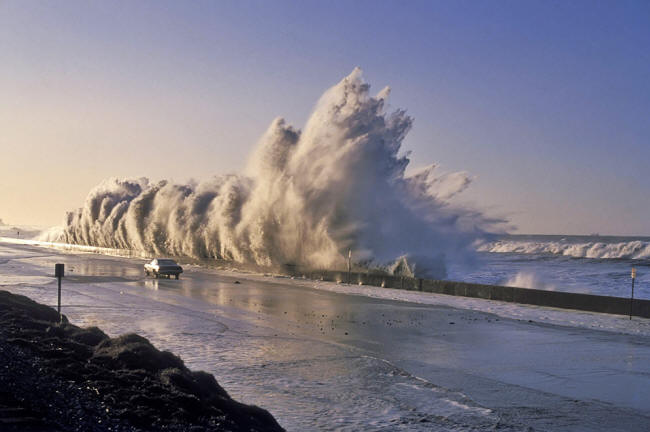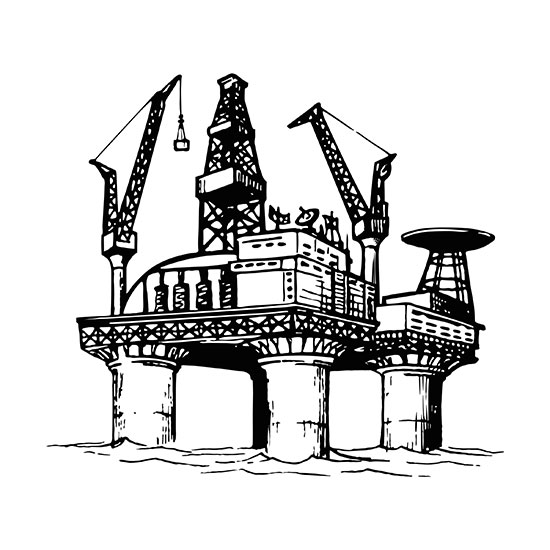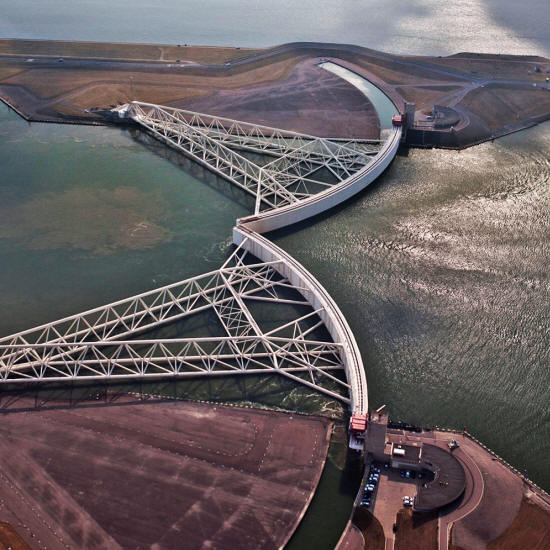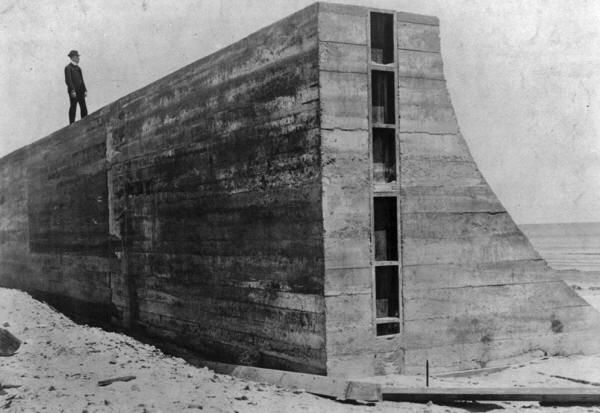|
Every day
brings fresh headlines blaming
Here is why this story
doesn't hold up... who pushed it... and why we're safer than ever before...
An Extreme Climate
Why headlines blaming extreme weather on climate change don't hold up, the peril of catastrophism, and the case that we're actually safer than ever before...
A powerful hurricane swept through the city of Galveston, Texas, bringing a storm surge of over fifteen feet across an island that was only eight feet above sea level at its highest point.
Winds of 120 miles per hour lashed the city. Nine inches of rain fell in a day. The storm leveled much of the city's residential area, reducing tidy neighborhoods of wood-framed houses to vast fields of debris.
Perhaps as many as eight thousand people, 20 percent of the city's
total population, died. Another ten thousand were left homeless.
The U.S. National Weather Service was in its early days and its forecasting tools were primitive. The storm had been spotted by a few Caribbean weather stations and ships at sea.
But forecasters had little knowledge of its size or intensity and predicted that it would head east, across Florida and on to the Atlantic, rather than west toward the Texas coast. The city was also ill-prepared to weather a storm of such magnitude.
Over the previous several decades, a series of large storms had destroyed the coastal city of Indianola, 100 miles to the southwest.
In the aftermath of those storms, Galveston's leaders
considered building a protective seawall, but ultimately convinced
themselves that such an event was unlikely to hit their city.
Immigration, westward expansion, and urbanization brought large populations into floodplains and coastal regions across the United States.
These growing agglomerations of
poorly planned, densely populated communities had little hardened
infrastructure to speak of, and brought large numbers of people into
regular contact with extreme climatic events.
after the
hurricane of September 8, 1900
There were, By contrast, since 1940 only three climate disasters have claimed a thousand or more lives:
The story is much the same globally.
The more recent climate catastrophes with comparable death tolls, such as the cyclone that killed up to half a million people in what is now Bangladesh in 1970, and the typhoon and resulting dam failure that took a similar toll in China in 1975 amid the chaos of the Cultural Revolution, have reliably occurred at the intersection of poverty, dense population, inadequate infrastructure, and failing political institutions.
We tend to think of natural disasters as natural. But the thing that determines how disastrous they are is mainly what humans do, not what nature does.
Discussions of weather-related natural disasters in recent years have largely focused on one particular human factor: the consequences of an anthropogenically warming planet.
But the heavy concentration of catastrophic disasters prior to the period when climate change began to significantly warm the planet should remind us that the earth's climate has always been highly variable, extreme, and dangerous.
What determines whether hurricanes, floods, heat waves, and wildfires amount to natural disasters or minor nuisances, though, is mostly not the relative intensity or frequency of the natural hazard but rather how many people are in harm's way and how well protected they are against the climate's extremes.
Infrastructure, institutions, and technology mediate the relationship between extreme climate and weather phenomena, and the costs that human societies bear as a result of them. Air conditioning mitigates suffering during heat waves.
Dams, reservoirs, and flood control systems keep water from inundating population centers during intense rainstorms.
Building codes and hardened infrastructure help the built environment withstand hurricanes, tornadoes, and other extreme weather events. Multi-day forecasts, early warning systems, and emergency response capabilities allow people to anticipate climatic extremes, prepare for them, and survive them.
The implications of this point will be counterintuitive for many.
Yes, there are many types of disasters, like hurricanes and floods, that are causing greater economic costs in many places than they used to. But this is almost entirely because the places that are most exposed to weather disasters have far more people and far more wealth in harm's way than they used to.
Even if there were no global warming, in other words, these areas would be much more at risk simply because they have much more to lose.
Once you factor out how many more people and how much more economic activity are in exposed areas, the economic costliness of weather extremes in recent decades has generally been flat or declining, not rising.
The human costs, meanwhile, measured by deaths associated with climate and weather extremes, have fallen dramatically over the last century.
Improving infrastructure and technology have made most people much more resilient to climate hazards today, even in relatively poor regions and even as the climate has warmed.
Average annual disaster deaths
excluding those from
volcanic eruptions and earthquakes Processed by Our World in Data and The New Atlantis.
Still, there has been no shortage of tragedies associated with extreme weather events in recent decades.
But where they do occur, it is almost entirely due to failures of institutions and infrastructure, not the additional extremity of the weather event due to climate change.
Two under-engineered and long-neglected dams in the divided country of Libya, racked for years by civil war, fail, sending a torrent of flood water into a large city and killing thousands.
While Lahaina, Hawaii, is ablaze, Maui authorities fail to send out an evacuation warning and close the main road out of the city, as fire hydrants run dry amid years-long fights over water supply, resulting in a hundred avoidable deaths.
Katrina, a strong but not exceptional hurricane, makes landfall over New Orleans, a city that sits mostly below sea level with a large low-income population living in the shadow of levees that haven't been properly built or maintained, killing well over a thousand.
These disasters were human-caused. But the human causes that turned these extreme events into terrible disasters were failures of infrastructure and institutions. Climate change was not the decisive factor.
One would be hard-pressed to glean this crucial distinction from media outlets like the New York Times, the Associated Press, and CNN.
Seemingly every day, we are bombarded by news of yet another extreme weather event that is attributed to climate change.
And while there is evidence that climate change is influencing some of these events, the role it is playing in most of them has been reliably exaggerated.
The consequences of this misattribution are significant.
The capture of the media by a catastrophist climate narrative has directed public attention away from straightforward measures that policymakers can take to reduce our vulnerability to the climate's extremes.
It has allowed politicians, in the wake of climate-related disasters, to divert attention from their own failures by pointing the finger at fossil fuel companies.
It has amplified the claims of an increasingly unhinged climate movement that has consistently polarized public sentiment on the issue and undermined practical efforts to reduce emissions and transition the world toward cleaner energy.
And it has left many people gripped by a terror about the future that solves nothing and isn't justified to begin with.
In the media, the environmental advocacy community, and much of the academy, the basic mental model for how climate change will impact human societies is typified by the famous poster for Al Gore's Oscar- and Nobel-winning film, An Inconvenient Truth, showing a hurricane coming out of a smokestack.
In the popular imagination, human combustion of fossil fuels warms the planet, leading to epic hurricanes, floods, heat waves, droughts, and wildfires that devastate societies.
Yoshigi Huang / Flickr Watch video HERE...
The first part of this notion is unquestionably true:
But the second part, that,
Day to day, week to week, season to season, and year to year, there is enormous natural variability at every level of the earth's geography and topography, and in relation to virtually every climate-related phenomenon that impacts human societies.
The main source of climate variability in the past, present, and future, in all places and with regard to virtually all climatic phenomena, is still overwhelmingly non-human:
Indeed, natural variability is far greater across all temporal and geographic dimensions than even quite extreme scenarios for anthropogenic climate change can begin to produce.
Large human populations, for example, occupy capitals as cold as Ulaanbaatar, Mongolia, with an annual mean temperature of 0 degrees Celsius, and as hot as Khartoum, Sudan, with an annual mean temperature of 30.
Even equatorial regions, where temperatures are relatively stable, can range from 21 to 31 degrees from season to season and 16 to 32 degrees from night to day. Compare that to extreme projections of, at most, 4 or 5 degrees Celsius of average warming globally by the end of this century.
The idea, then, so perfectly captured by the poster for An Inconvenient Truth, that a few degrees of warming would result in powerful hurricanes and intense heat waves materializing out of thin air was always implausible.
We know that anthropogenic warming can increase rainfall and storm surges from a hurricane, or make a heat wave hotter.
But there is little evidence that warming could create a major storm, flood, drought, or heat wave where otherwise none would have occurred, rather than making ones that would have happened anyway somewhat worse.
The main effect that climate change has on extreme weather and natural disasters, in other words, is at the margins.
A heat wave in which daily high temperatures over the course of, say, a week never dropped below 99 degrees Fahrenheit in the absence of climate change would instead never drop below perhaps 102 or 103 degrees with the warming that the Earth has experienced to date.
A rain event that dropped 10 inches of rain over 48 hours instead produces 11 inches of rain because of climate change. And so on.
These examples represent phenomena in which the effects of climate change are most straightforward and direct.
One or two or three degrees Celsius of increase in the average background temperature results in extremes, both warm and cold, being one or two or three degrees warmer, possibly a bit more, possibly a bit less, depending on the event and location.
Similarly, a degree of warming results in the atmosphere holding about 7 percent more water vapor, which translates to about the same percentage increase in rainfall.
In these cases, climate science theory and observations are well aligned. Climate change has increased the frequency of extreme heat events and decreased the frequency of extreme cold events.
It has led to global sea level rise and glacial melting.
At the regional level, some areas have also seen increases in phenomena like extreme precipitation events that are very directly linked to warming global temperatures.
But for most climate and weather phenomena, the effects are much more complicated and don't always run in the same direction. Warmer surface and ocean temperatures, for instance, produce more rain from hurricanes, because warmer air can hold more water vapor.
But climate change can also create countervailing factors, such as increases in wind shear, which may make it harder for hurricanes to develop and persist, and decrease their frequency.
Media accounts have been quick to tie hurricanes and other complex phenomena to climate change. But there is little data to suggest, thus far, that these events have actually gotten worse.
The share of tropical cyclones that are Category 3 to 5, the strongest storms, has risen in recent decades. But overall tropical cyclone activity has decreased.
As a result, the absolute number of major storms has remained fairly steady over time.
Includes all recorded tropical cyclones
(depressions, storms,
hurricanes, and typhoons) worldwide for Climate Stewardship data
The situation is similar with other complex weather phenomena.
Globally, the area burned by wildfires has decreased. There has been no detectable global trend in river floods nor for the total land area flooded. There is likewise no detectable trend globally in meteorological drought.
Regionally, the trends vary, with some parts of the world seeing increases in phenomena such as flooding, wildfire, and rainfall, and others seeing decreases.
The area burned by wildfire in the Western United States, for instance, has increased.
But climate change is just one contributing factor, alongside the long-term increase in fuel loads in U.S. forests due to a century of fire suppression and the fact that there are a lot more people living in forested areas to start fires.
Many extreme weather events will continue to intensify, or become more frequent, absent rapid cuts in global emissions, as the climate continues to warm. But like today, the effects will continue to be on the margins of natural variability.
IPCC projections suggest that the 1 extra inch of rain that global warming now adds to a once-in-fifty years 10-inch rainstorm will instead be 3 or 4 extra inches if we hit 3 degrees of warming.
High temperatures in a heat wave that today hit 42 degrees Celsius might hit 45 or 46 degrees with 3 degrees of warming.
Global warming-induced sea level rise of, on average, 9 to 10 inches globally over the last 150 years might rise another foot or two by 2100.
There is also concern about so-called "tipping points" - the possibility that some processes could result in a step change in the way that warming affects the climate.
Some scientists have proposed, for instance, that climate change might result in a slowing down of the Atlantic Meridional Overturning Circulation, the system of ocean currents through which the Gulf Stream brings warm water to the North Atlantic and moderates temperatures across much of Europe.
Others suggest that the thawing of permafrost, and of methane hydrates on the seafloor, could result in rapid release of methane and accelerate warming, or that ice sheets in Greenland and Antarctica could disintegrate rapidly, leading sea levels to rise much faster than most current estimates suggest.
But while it is clear that continuing warming risks triggering these and other potential tipping points, those that function at global scales and have the potential to significantly impact the global climate do not appear to be particularly abrupt phenomena that would bring major and immediate global impacts.
When scientists speak of things like "rapid" release of methane or melting of ice sheets, they generally mean rapid in geological time. These processes would unfold over centuries or millennia, not decades.
We don't precisely know, moreover, how much additional warming would be necessary to trigger many of these tipping points. Nor do we even know if the feedbacks will all run in the same direction, toward a hotter planet.
One recent review of the literature, "Mechanisms and Impacts of Earth System Tipping Elements," concluded that a cascading series of tipping points and climate feedbacks, taken together, might in the worst case increase warming by half a degree Celsius by 2300.
Some of these changes would be irreversible. Thawing methane from the sea floor would never be restored and major ice sheets in Greenland and West Antarctica would take hundreds of thousands of years to recover if they were lost.
But there is little basis for claims that surpassing these tipping points risks triggering irreversible, runaway warming, as many people have long feared.
Rather, climate change over the rest of this century will make the world marginally hotter almost everywhere. It will make some weather events such as extreme rainfall more intense than they otherwise would be.
And it will result in some other extremes being more frequent or intense in some parts of the world and less so in others.
But it will not shift the basic function of the Earth system into a profoundly different state, one that human societies are entirely unfamiliar with, or create weather extremes far outside the range of extremes that human societies have dealt with in various geographies that they have long inhabited.
Houses Upon the Sand
The real human causes of natural disasters...
Each year, Munich Re, the global reinsurance colossus, releases damage estimates of the total cost of natural disasters around the world.
Decade over decade, that cost has risen, to over $200 billion annually in recent years. Between 1990 and 2017, the global cost of weather-related disasters increased by 74 percent, according to an analysis of this data by University of Colorado professor Roger Pielke, Jr.
Media accounts frequently suggest that the increase in billion-dollar weather disasters in the United States is due to climate change, as does the Biden administration.
But if climate change is behind the increasing cost of natural disasters, then you would expect that the cost of disasters related to weather would be rising faster than that of disasters not related to weather.
Nobody, after all, suggests that climate change is resulting in more severe earthquakes or more frequent volcanic eruptions. Instead, the opposite is true. The cost of disasters unrelated to weather increased 182 percent between 1990 and 2017, more than twice as fast as for weather-related disasters.
In truth, it is economic growth, not climate change, that is driving the boom in economic damage from both weather-related and non-weather-related natural disasters.
All over the world, there is far more wealth in harm's way that can be damaged by natural disasters.
Consider the familiar and oft-cited example of hurricanes hitting the United States. Year to year, the number and severity of storms that make landfall in the North Atlantic basin, and particularly in Florida, will largely determine whether extreme weather costs increase or decrease for the whole world.
Florida has regularly been hit by strong hurricanes over the last 75 years, and the costs of those hurricanes have increased massively.
But the reason that those costs have increased so much is because the state's population and wealth have grown enormously.
The population of Miami-Dade County alone, where a large share of the state's disaster-exposed wealth is located, has risen from a bit less than 500,000 in 1950 to 2.8 million today.
Per capita income data for the county from an economic database provided by the Federal Reserve System only go back to 1969, but even over that period, it has risen from around $4,000 per person to over $68,000 today.
Taken together, the enormous increase in population and wealth in the region drowns out any identifiable economic signal from climate change.
With or without climate change, the economic cost of hurricanes in Florida would be vastly higher now than in the past.
This dynamic, called "exposure" by those who study disaster risk, dominates the economics of virtually every kind of climate-related disaster.
When the Munich Re data is calculated as a percentage of GDP rather than simply looking at the increase in the absolute costs of extreme weather, global damages resulting from extreme weather have actually fallen since 1990.
And that doesn't fully reflect the degree to which increased wealth exposed to extreme weather in places like Miami dominates global economic costs of disasters.
Since 1950, accelerating urbanization has resulted in an enormous shift of the global population, economic activity, and wealth into coastal regions, river floodplains, and other regions that are most exposed to climate-related hazards.
These agglomeration effects, as economists call them, mean that the increase in population and wealth in these regions has significantly outpaced the already unprecedented rate of economic growth globally since 1950.
The relationship between climate change, extreme weather, and disaster costs is further complicated by another important factor that determines how human societies are affected by climate extremes.
Things like stricter building codes, hard and soft infrastructure, better technology, and a range of other factors make people and property far more resilient to the weather.
Disaster risk experts call this factor "vulnerability." And vulnerability to extreme weather has been falling significantly all over the world for many decades.
While trends in exposure are increasing the costs of weather-related disasters, trends in vulnerability are reducing those costs.
Between 1980 and 2016, according to an analysis of Munich Re's data by researchers Giuseppe Formetta and Luc Feyen, global losses from weather disasters ballooned by $2.6 billion per year, due to the growth in economic activity that was exposed to those disasters.
But losses as a share of the economic activity in exposed areas shrank by a factor of more than four (See Figures 3 and 4.)
In the 1980s, when climate-related disasters struck, the average cost of the damage within 250 miles of the disaster was 8 percent of the GDP produced within the same area.
By 2016, that figure had fallen to less than 2 percent.
Because of economic growth and agglomeration effects, there was much more economic activity in harm's way. But because wealthier societies have greater resources to put toward climate resilience, that wealth also became much less vulnerable to extreme weather.
Reported damages globally. These figures do not capture all damage from natural disasters, but track changes in damage from specific types of hazards related to climate: coastal floods, flash floods,
general floods,
extreme cold, extreme heat, droughts, and wind. Figure 1. Open access.
Once you account for increased exposure and reduced vulnerability - or "normalize" for these factors, as researchers call it - there is next to no evidence that climate change has increased the costs of weather disasters anywhere.
A comprehensive analysis of 54 different studies of these cost trends, "Economic 'normalisation' of disaster losses 1998-2020 - A literature review and assessment," also authored by Roger Pielke, found that only one of those studies showed increasing costs from weather damage that could be attributed to climate change.
Improving resilience against the climate's extremes: Damage inflicted within 250 miles of climate-related disasters as a share of the GDP within those areas. This figure tracks the same events as Figure 3,
and uses a
ten-year trailing average. Open access.
Vulnerability has an even greater influence on the human costs of extreme weather than on the economic costs.
While a strong hurricane making landfall in a rich country will have a far greater economic cost than in a poor country, because there is so much more wealth exposed to the hurricane, the same hurricane will have a far greater human cost in the poor country, measured by deaths and injuries.
Take the real-life example of Haiti and the Dominican Republic. The two Caribbean nations share the same island. Each nation has a population of around 11 million people.
The Dominican Republic is not a rich nation. But its per capita income is about six times greater than Haiti's.
In 2004, Hurricane Jeanne made landfall on the eastern tip of the Dominican Republic as a Category 1 hurricane, demonstrating the extraordinary influence that vulnerability has on the human costs of natural disasters, with tragic consequences for Haiti.
By the time the storm had crossed the island and reached Haiti, it had been downgraded to a tropical depression. Still, it killed over 3,000 people in Haiti and only 19 in the Dominican Republic.
The difference in the human cost of Hurricane Jeanne in Haiti and the Dominican Republic demonstrates that poverty and weather extremes are a deadly mix.
Thankfully, increasing wealth, infrastructure, technology, and public services have massively reduced vulnerability to extreme weather and natural disasters over the last century.
Even as the global population has risen from less than 2 billion people in the 1920s to 8 billion today, deaths from climate-related disasters have fallen dramatically, from around 500,000 annually then to 30,000 now.
Measured on a per capita basis, climate-related mortality has fallen by a factor of more than fifty.
These comparisons flatter the past.
There is a strong reporting bias toward the present, since most parts of the world didn't reliably track disasters and their consequences until relatively recently, meaning that actual climate-related mortality in the first half of the twentieth century was almost certainly far higher than available data suggests.
David Olsen / Alamy
Vulnerability, moreover, is falling fastest in poor countries.
Formetta and Feyen find that poor countries have seen much greater reduction in climate vulnerability than rich countries since the 1980s.
As the resilience of poor countries has improved, the vulnerability gap between rich and poor countries has dramatically narrowed.
None of this evidence should be taken as suggesting that climate change is not happening and is not having some impact on weather, disasters, and the consequences that they bring to human societies.
But if human society is currently in the midst of a climate emergency, as many people now believe, there is little measurable evidence thus far that it is an emergency of dollars or lives lost.
Selling the Story
the extreme weather strategy...
That experience is due, in part, to the ubiquity of digital media and communications technology.
Just a few decades ago, a major flood in, say, Uzbekistan would have gone largely unnoticed elsewhere, perhaps meriting a line or two in a wire service report.
Today, it will likely be captured on video by a cell phone or
surveillance camera, and, if it is spectacular enough, will show up
in viral social media posts and, increasingly, the homepages of
major media outlets.
From the very beginning - when Senator Tim Wirth timed the introduction of the first federal proposal to reduce carbon emissions for the heat of the Washington summer and brought James Hansen to Washington to provide groundbreaking testimony on the reality of anthropogenic climate change in a stiflingly hot conference room in the U.S. Senate - environmentalists and their allies have sought to recode extreme weather as climate change.
In the 1990s, the Clinton administration invited NBC Today Show host Al Roker and dozens of other TV weather forecasters to the White House to be briefed on global warming, in hopes that they would vouch for the Kyoto Accord and convey the seriousness of climate change to their viewers.
Those efforts intensified after Hurricane Katrina struck New Orleans in 2005, with Al Gore using it as a centerpiece in An Inconvenient Truth.
A few years later, in 2012, the Union of Concerned Scientists convened a gathering of environmental advocates, litigators, climate scientists, and opinion researchers in La Jolla, California.
Their explicit purpose was to develop a public narrative connecting extreme weather events that were already happening, and the damages they were causing, with climate change and the fossil fuel industry.
The proceedings from that gathering, which were subsequently published in a report titled "Establishing Accountability for Climate Change Damages: Lessons from Tobacco Control," are revealing.
Myles Allen, the climate scientist who is credited with creating the field of "extreme event attribution," is described in the report as lamenting that,
Yet, he and other scientists at the gathering also acknowledged how difficult it is to identify the contributions of climate change to current extreme weather events.
While much of the convening was ostensibly focused on litigation strategies, modeled on campaigns against the tobacco industry, the subtext of the entire conversation was how to raise the public salience of a risk that is diffuse, perceived to be far off in time and space, and associated with activities - the combustion of fossil fuels - that bring significant social benefits.
During the meeting, Naomi Oreskes, the Harvard historian of science who popularized the connection between climate and tobacco, argued that scientists should use a different standard of proof for the relationship between climate change and extreme weather events.
But, she continued, the 95-percent confidence standard that scientists use,
Others suggested that reframing the attribution of extreme weather to climate change could allow for stronger claims:
And others believed that focusing legal strategies on a villain - fossil fuel companies conspiring to mislead the public about the danger of their product - would result in greater public acceptance of the claims that climate change was the cause of extreme weather.
As it happened, environmental advocates would pursue all of these strategies.
Researchers would comb through the archives of fossil fuel companies, going back to the 1970s and '80s to show that Exxon and others knew that fossil fuels caused global warming - a claim that was not as scandalous as it sounded, given that much of the research the companies cited in their internal records was actually public at the time.
Meanwhile, Friederike Otto, a protégé of Myles Allen, would go on to co-found World Weather Attribution (WWA), which developed a new statistical method for characterizing the probability that any given weather event would have occurred without climate change.
Otto's methodology attempts to quantify how much more likely climate change made the occurrence of a specific extreme event, say a heat wave that resulted in high temperatures above 101 degrees for a period of five days in a given location.
These estimates have been widely misunderstood as quantifying how much more likely climate change made it for the heat wave to occur at all.
But that is not what the method actually estimates.
Rather, it quantifies changes in the likelihood of the heat wave reaching the precise level of extremity that occurred. In the hypothetical case above, the heat wave would have happened in the absence of climate change, it just would have resulted in high temperatures above 99 degrees over the course of five days instead of above 101 degrees.
Otto and WWA are estimating the probability of a heat wave occurring that is marginally hotter than the one that would have occurred without climate change, not the probability of the heat wave occurring at all.
WWA has utilized Otto's new-fangled method to rapidly produce science connecting extreme events to climate change, with the explicit goal of shaping news coverage. And it has worked.
Coverage of climate-related disasters now routinely features WWA analysis, which is frequently used to suggest that climate change is the cause of these events.
CBS News, for instance, citing a WWA analysis, reported on its website last summer that heat waves at the time,
Another story from CNN named six recent droughts and heat waves that,
These headlines misrepresent both the actual role that climate change has played in these events and the actual conclusions of WWA's analyses.
Irrespective of what Exxon or anyone else knew in the 1980s, and contrary to reporting based upon Friederike Otto's event attribution studies, there is very little evidence that the costs, human or economic, of natural disasters would be significantly lower in a world without climate change.
But WWA's rapid-fire reports - alongside sustained advocacy claiming that a conspiracy by fossil fuel companies to deny the science of climate change is the reason why the world has not embarked upon far-reaching action to address the problem - have given journalists license to ignore the enormous body of research and evidence on the long-term drivers of natural disasters and the impact that climate change has had on them.
Efforts by environmental advocates to attribute extreme events to climate change coincided fortuitously with profound changes in the structure of the media, the business models of many media outlets, and the social and political culture of newsrooms in ways that have incentivized the presentation of extreme events as centrally implicating anthropogenic warming.
Not so long ago, news coverage needed to be credible to multiple audiences whose politics and values spanned a relatively broad spectrum of worldviews and values.
But the proliferation of media outlets and platforms in recent decades, first with the rise of cable news and then the Internet, has increasingly fragmented media audiences.
Today, media outlets large and small compete in a far more crowded marketplace to reach much narrower segments of the population.
This incentivizes them to tailor their content to the social and political values of their audiences and serve up spectacles that comport with the ideological preferences of the audiences they are trying to reach.
For the audiences that elite legacy outlets such as the New York Times now almost exclusively cater to, that means producing a continual stream of catastrophic climate news.
Reporters and editors at these outlets are also well-aligned ideologically with their audiences.
A national survey of political journalists and editors working for newspapers at the state and national level conducted in 2022 found that those identifying as Democrats outnumbered those identifying as Republicans by 10 to 1.
A 2018 survey of environmental journalists by George Mason University's Center for Climate Change Communication, meanwhile, found that 70 percent reported trusting information from environmental advocacy organizations versus fewer than 10 percent from business groups.
Seventy-one percent reported that they never or rarely included opposing viewpoints in their coverage of climate change.
The alignment of audience-driven incentives for media outlets to produce catastrophic climate content with the environmental commitments of the journalists and editors producing it has been further reinforced by the media's search for new revenue streams to compensate for the collapse over the last two decades of the subscription and advertising revenue on which newspapers, radio, and television once depended.
In the face of these challenges, legacy media outlets have pursued a range of new business strategies to increase revenue, including philanthropic funding and corporate support.
The explosion of climate reporting in major venues has been underwritten in significant part by environmental philanthropy.
Grantmakers such as the Rockefeller, Walton, Hewlett, and Ford foundations now funnel millions into climate journalism, funding everything from dedicated climate reporting at specialty outlets like Grist and Inside Climate News to general climate coverage and climate-themed events at major media outlets like the Associated Press, CNN, and the Washington Post.
This has gone hand and hand with the development of lucrative new events, in which high-profile legacy media outlets host big environmentally-themed conferences, such as the Economist's Sustainability Week, the New York Times's Climate Forward event, or the Washington Post's This Is Climate summit.
Media outlets sell five- and six-figure sponsorships to corporations for conferences whose audience, in turn, is overwhelmingly composed of corporate sustainability professionals with large budgets at their disposal to pay conference registration fees that can run upwards of $1,000 per participant.
Together, the dynamics described above are self-reinforcing and have led to the widespread perception among elite audiences that the climate is spinning out of control.
New digital technology bombards us with spectacular footage of extreme weather events. Environmental scientists have created misleading new methods to connect those events to climate change. Catastrophist climate coverage generates clicks from elite audiences.
Environmental journalists almost uniformly share the same environmental views as their core audiences. Environmental philanthropy helps pay for climate coverage.
And the business side of legacy media has figured out how to monetize it through corporate sponsorships of and participation in lucrative conferences.
In the face of this, it hardly matters that claims that extreme weather and disasters all over the planet are caused by anthropogenic climate change fly in the face of most of the well-documented trends in their frequency, intensity, and cost.
Armed with a convenient new sub-science that justified their priors, and convinced that they were combating a decades-long misinformation campaign by the fossil fuel industry, journalists charged ahead, determined to fight fire with fire.
Naomi Oreskes's call for a lower standard of evidence for public communication of climate science has been broadly adopted, not only by environmental advocates but by their allies in the media and the academy.
The Cost of Catastrophism climate doom fatigue...
Yet there has never been much evidence that connecting extreme weather and natural disasters to climate change in this way would actually work to motivate action on climate change, and plenty of evidence that it wouldn't.
As early as 2000, a cognitive linguistics
outfit called the FrameWorks Institute, hired by environmental NGOs
to investigate new communications strategies to raise public concern
about climate change, concluded that connecting climate change to
extreme weather motivated adaptive and individualistic responses
from the public, including, laughably, greater interest in
purchasing an SUV, not collective demands for government action. Since then, numerous studies have concluded that catastrophic messages about climate change tend to provoke fatalism, not activism.
A 2009 paper, "Fear Won't Do It," for instance, found that,
Another study, from 2010, "Apocalypse Soon?," found that,
Even in the workshop convened by the Union of Concerned Scientists, public opinion experts warned that catastrophic messages and demonizing fossil fuel companies could backfire.
And that is exactly what has transpired over the last several decades.
The issue remains near the bottom of public priorities in opinion surveys - it ranked 17th out of 21 in a recent Pew survey.
Support for climate action waxes and wanes in a dynamic called thermostatic response, where public opinion is strongest in opposition to the party in power, meaning that support for climate action tends to be higher under Republican presidents than Democratic.
With Democrats currently in charge, public support is again waning. Indeed, according to Gallup, which has conducted the longest-running survey of public opinion about climate change, public concern about global warming is marginally lower today than when Gallup first asked the question in 1989, with 61 percent now saying they are greatly or fairly worried about global warming, down from 63 percent then.
The main effects of efforts to move climate catastrophe into the present and blame it on fossil fuel companies have been to polarize the issue and induce paralyzing fatalism and anxiety, precisely as researchers long predicted.
While public worry about climate change is no higher than it was when Al Gore sounded the alarm in An Inconvenient Truth, it is much more polarized, with Democrats more worried than they used to be and Republicans less so.
The climate issue has become a permanent fixture in America's long-running culture war.
Meanwhile, climate anxiety is rampant, particularly among the young.
Climate scientists, activists, and journalists increasingly rage against climate "doomers" - people who believe that it is too late to save humanity.
And a new generation of apocalyptic activists has now taken to vandalizing famous artworks and gluing themselves to roadways to block rush hour traffic in a misguided effort to get the public to wake up to what they insist is the looming threat of human extinction.
Despite this, the folk theory persists among much of the environmental cognoscenti that climate action requires that the public be convinced that a climate catastrophe is now unfolding, and that it is demonstrable in every extreme weather event.
This theory of change is sustained, at bottom, not so much by strategic considerations as a foundational ideological commitment that is deeply embedded in modern environmentalist identity.
A movable storm-surge barrier in Rotterdam, Netherlands,
in its closed
position
Sure, it may be difficult to find a large or determinative climate signal in extreme weather events. And the trends in terms of mortality and cost may point in a different direction.
But the idea that human perturbations of the environment, even seemingly minor ones, could throw nature out of balance and lead to catastrophic consequences for human societies is as old as environmentalism itself, a thread running back at least to Rachel Carson's Silent Spring and probably much further.
The logic of climate catastrophe follows this chain of reasoning exactly.
The combustion of fossil fuels results in an increase in concentrations of a trace gas in the atmosphere, shifting the Earth's energy balance and resulting in a degree or three or five of warming of the average temperature of the Earth, which in turn produces biblical plagues of floods, droughts, storms, heat waves, and rising seas. Calamity ensues.
The first several steps in this chain of logic, up to and including the warming of the Earth, are unquestionably true. But the plagues and calamity are not.
While warming will continue as long as the global economy emits greenhouse gases, most estimates today conclude that anthropogenic warming is likely to be substantially lower by the end of the century than estimates from as recently as a decade ago.
In 2013, the mean end-of-century projection was 4 degrees Celsius of warming above pre-industrial levels, with many scientists assuming that the worst-case scenario of up to 5 degrees was also the most likely.
Current estimates today top out around 3 degrees, while the worst-case scenarios suggesting significantly more warming are now widely understood to be highly unlikely.
But rather than update their priors in response to these facts, most environmental scientists, journalists, and advocates have simply shifted catastrophic claims from 5 degrees of warming to 3 degrees, the commitment to catastrophism being, at bottom, more epistemic than scientific.
Even among those who acknowledge that specific catastrophist claims are not particularly well supported scientifically, many believe them to be justifiable as a form of harm reduction.
But one need not look far to find all sorts of ways that this particular brand of harm reduction actually causes harm. Consider that some prominent leaders now propose limiting adaptation aid for developing countries to projects and activities that involve no fossil fuel use.
This despite the clear adaptation benefits that fossil fuels offer poor countries and despite the fact that both rich countries and poor continue to depend on fossil energy for the vast majority of their energy needs.
The topic became a sticking point at the U.N.'s recent climate conference.
Worse, a 2022 report by CARE International, "That's Not New Money," finds that international commitments from rich countries to increase support for climate mitigation and adaptation in poor countries have resulted in little overall increase in global aid but rather diversion of funding from proven development programs supporting health, education, and women's rights.
Meanwhile, a recent analysis by the Economist concluded that high energy costs across Europe during Russia's war on Ukraine, driven in part by climate policies that increased the continent's dependence on Russian gas, resulted in 68,000 excess deaths in the winter of 2022-23.
And California, led by its powerful Air Resources Board and at the behest of its well-heeled environmental community, has implemented a wide range of regressive housing, land use, transportation, and energy policies that have raised living costs and limited opportunities for high-wage employment for its low-income residents.
Among those within the climate movement even willing to acknowledge these consequences, there has been little willingness to entertain the possibility that unfounded and exaggerated framings of catastrophic climate risk might have something to do with the promulgation of ill-conceived climate policies that often impose substantial costs upon those who are least responsible for emissions, and least able to pay the costs of the energy transition.
But it is hard to conclude that the catastrophist claims of the climate movement, amplified through a media echo chamber, haven't had something to do with the determination by ideologically aligned policymakers to undertake these efforts.
There has always been a compelling case for action to cut emissions and shift away from the use of fossil fuels that requires neither prophesying human extinction nor insisting that every extreme weather event is now brought to you by Exxon.
Consider that indoor and outdoor air pollution, largely due to combustion of fuels for heating, cooking, power generation, transportation, and industry, results in between 7 and 9 million premature deaths a year.
A temperate climate, moreover, is clearly a desirable objective to pursue, even given that humans are likely capable of adapting to climate change reasonably effectively.
Just because air conditioning and other measures can allow large human populations to live in places like Phoenix and Riyadh as they become hotter doesn't mean we shouldn't attempt to limit how hot those places will become.
There is also the small matter of the rest of creation, the riot of life on Earth that has not been bred, modified, or otherwise gang-pressed into serving human material needs.
Many of the Earth's ecosystems and much of its biodiversity will not be able to adapt to a significantly warmer climate, particularly because humans have commandeered so much of the terrestrial surface for agriculture, cities, roads, mining, and other activities, fragmenting the habitat that remains for other life forms.
These garden-variety environmental considerations, along with non-environmental objectives such as cheap, abundant, and reliable energy, remain substantially higher public priorities than climate change in most opinion surveys.
But these concerns also fail to provide much justification for the sweeping demands of the climate movement.
Apocalyptic claims about an unfolding emergency, rather, serve a millenarian agenda that variously demands that we abolish capitalism, bring about an end to economic growth, power the global economy entirely with wind and solar energy, feed the global population only with small-scale organic agriculture, and cut global emissions in half over the next decade or two.
Against these claims, which insist catastrophe looms absent radical action, the actual trajectory of the global economy is quite different.
Global emissions appear to be close to peaking, even as energy demand continues to rise rapidly in many poor and middle-income countries, which increasingly meet that demand through a combination of more-efficient end-use technologies, renewables, nuclear power, and lower-carbon natural gas instead of coal.
Meanwhile, in the developed world, emissions have significantly fallen over the last several decades as population growth slows, economic growth shifts toward less-carbon-intensive knowledge and service sectors, and cleaner technology replaces dirty.
Simply assuming continuing incremental improvements in technology and policy, one recent paper in Environmental Research Letters finds that the world could achieve net zero emissions and stabilize the climate at just over 2 degrees, the long-time international target for stabilizing emissions, by the end of this century.
Achieving net zero and stabilizing the climate could happen somewhat faster or slower. But not that much faster or slower.
The study analyzed a range of plausible scenarios produced by the IPCC and concluded that none resulted in over 3 degrees of warming, with most resulting in less than 2.5 degrees.
That is a world in which the economic cost of all disasters will continue to rise, simply because there is more wealth for those events to damage.
More importantly, that increasingly prosperous and technological world will likely continue to see falling mortality rates from climate-related disasters, even as some types of extreme weather do intensify.
Taken together, these factors paint a far different picture than the dire warnings of doom that dominate most news coverage of climate change, environmental advocacy materials, and grandstanding speeches by world leaders at U.N. climate conferences such as the recent summit in Dubai (COP28).
There is little evidence that climate change has, or is in imminent danger of, tipping the world into a new state of imbalance in which a raging climate threatens the survival of the human species or societal collapse.
The world, rather, has made real progress to both limit warming and adapt to the climate we actually live in.
The Galveston sea wall under construction
after the hurricane
of 1900
Galveston itself offers a useful lesson in renewal and resilience. In the years after the Great Hurricane of 1900, the city rebuilt.
Over time, it has raised the elevation of some parts of the city by more than 10 feet, built a seawall to protect it from storm surges, and replenished its sand dunes.
Those were costly projects, built by a community that was far poorer than it is now. Yet today, Galveston is a thriving city, with a 40 percent larger population than lived there in 1900.
In the century since the Great Hurricane, the city has been regularly hit by strong hurricanes. But none has resulted in more than a few dozen fatalities.
And while every death from a natural disaster is a tragedy, Galveston's story is a profoundly hopeful one.
It is also a story not remotely limited to Galveston, one that is playing out all over the world, as modernizing societies, rich and poor, have deployed technology and infrastructure to tame the impact of extreme weather.
Galveston reminds us that while the climate is still warming, human societies have always had to contend with dangerous weather.
We know how to increase resilience to climate extremes. We also know how to reduce emissions - many nations have been doing so for decades.
Cutting emissions and adapting to a warming climate requires neither bombarding the public with apocalyptic threats nor imposing arbitrary targets and deadlines for the elimination of all fossil energy.
Rather, it requires doubling down on the things that we already know work: modernization, adaptation, innovation, and technological change.
|


